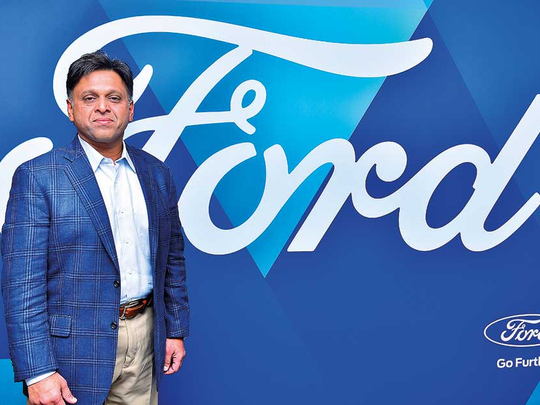
Dubai
For Ford, there is no budging from what it wants to get out of self-driving vehicles. The US carmaker has hitched this to a city’s future transportation needs and not how an individual might want to use it.
Such a distinction serves a clear purpose — “My view is there is a significant gap between technology in vehicles and the chaos we experience on the roads,” said Raj Rao, CEO at Ford Smart Mobility, which was set up to oversee all of the manufacturer’s push into connected and autonomous-driving vehicles.
“Having (independent) autonomous vehicles participate in the chaos is just a bad idea. You don’t want to be sitting in traffic whether the vehicle is automated or not. It’s very unproductive. More of tech is not the solution, and no one wants another mode of (private) conveyance entering this ecosystem of chaos.”
- Raj Rao | Ford Smart Mobility CEO
Ford’s approach is markedly different from what some of the competition have been pursuing, as well as the concepts put forward by Silicon Valley tech giants. In their vision, self-driving is for all, cities and the individual alike. “Global cities need to solve this gridlock, and we think the way to solve this is by carrying greater (public) transportation capacity,” said Rao, who signed on as CEO just over a year ago. “Cities need to address that now and AVs are very much part of that future. We want to solve a more complex challenges that cities face in organising mobility to reduce congestion. This needs to be done while introducing new technology and not after.”
That’s where Ford comes in. And it is putting in the people and funds behind it. Consolidating all of its push under the Ford Smart Mobility banner is part of it, and there have been acquisitions to get the process up to speed. “We have to figure how we can participate economically in what cities want to do with their transportation. There are enormous amounts of investment going into city mobility.”
And it’s not as if such initiatives are confined to a handful of US cities or in Europe. Dubai’s has been speaking about bringing in “smart” features to its rapidly evolving public transport. It is tapping feedback on how its residents use private and public methods to go about their daily work schedules.
But for automotive giants, will the search for autonomous driving solutions come at a price for themselves? “Mobility services is an attractive business to be in and there’s no need to think we won’t earn a healthy economic profit when we do it at scale,” said Rao. “It allows us to reach a much larger audiences and not just with the vehicles. If you play that well, you can attract a very healthy return for the company.”
Rao does not buy the argument that such a focus could come to hurt its core business — that of getting people to buy the cars and SUVs it makes.
“The way we see it, the city of tomorrow is about liberating the human journey,” said Rao. “What we are doing is taking the Ford brand and adding mobility services to what it stands for in the future. We are not doing anything to take the ownership experience away from that.
“Our view is that at the end of the day are consumer. A consumer may choose to use the service in different ways. In some situations, they may choose to own a vehicle; in other scenarios, they may choose to hail or choose an electric car. In the future they may want to sit in an autonomous vehicle.
“It’s important how we keep up how users want to be served. That’s breaking down a lot of boundaries.”
Most of the global auto manufacturers have fully signed up for the new direction the industry is taking, whether it be electric or autonomous. Or a mix of both.
But, internally, within the companies themselves, have things changed? “The human view before was how will someone use a vehicle,” said Rao. “Going forward, it will be how people interact with transportation.
“That work has to be done as one company, not three separate entities. The user wants that relation to be unified in the different ways they interact with the Ford brand.”
For auto industry, it’s all about getting connected inside and out
By 2019, all of Ford’s new vehicles launched in the US will be built with full-on connectivity. The company plans to touch the 90 per cent mark for all of its new vehicles launched globally to feature connectivity by 2020.
Specific to autonomous vehicle development, Ford recently announced an alliance with the ride-hailing service provider (and Uber rival) Lyft. And even struck a collaboration with Domino’s Pizza to research the customer experience of delivery services.












